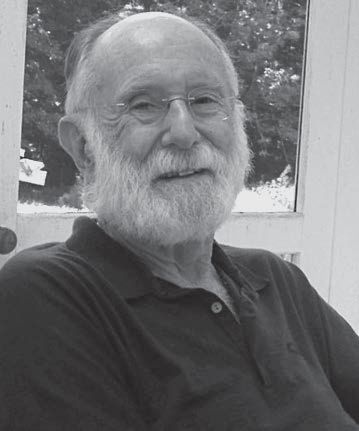
Physiology News Magazine
Obituary: William Knox Chandler
1933 – 2017
Membership
Obituary: William Knox Chandler
1933 – 2017
Membership
Stephen Baylor,
Department of Physiology, University of Pennsylvania, USA
https://doi.org/10.36866/pn.107.51
William Knox Chandler, an eminent American physiologist, died on 20 March 2017, at the age of 83 of a haemorrhagic stroke. He was a member of the Yale University Department of Physiology from 1966 until his retirement in 2010, and a leading figure in the fields of nerve and muscle physiology.
Chandler’s work was recognised by his election to the US National Academy of Sciences in 1990. The citation described him as ‘the world’s leading investigator of excitation-contraction coupling’ (ECC), also noting that he ‘opened new areas of research in the cellular physiology of nerve and muscle.’ His 1973 article (with Martin F Schneider) reported the first measurement of muscle ‘charge movement’, a small non-linear membrane current of a skeletal muscle cell marking a voltage-dependent rearrangement of a protein known as the ‘dihydropyridine receptor’, which serves as the voltage-sensor of ECC. As suggested in that article, this protein rearrangement is an essential link in the chain of events that allows a muscle cell to contract in response to an action potential on its surface membrane.
Chandler was born on 13 October 1933 in Chicago. His father was a faculty member in the English Departments at Harvard University and Vanderbilt University prior to joining the US government in the early 1940s as an intelligence analyst. Following his father’s death during World War II, Knox (still a child) moved with his mother and brother Colston to Brownwood, Texas. At age 16, Knox graduated from Brownwood High School, where he showed exceptional promise in quantitative subjects. He attended college at Washington and Lee and then the University of Louisville, graduating in 1953 with a major in pre-medical sciences. He received the MD degree from Louisville in 1959.
While in medical school, he realised that he was not attracted to clinical practice but rather to the experiments that he carried out in the basement laboratory of Warren Rehm, a membrane transport physiologist. After medical school, Chandler worked at the National Institutes of Health in the laboratory of KS Cole, an inventor of the voltage-clamp technique. This was followed by a year-long fellowship at Brown University, where he studied mathematical methods of science. He then moved with his family to Cambridge, England, for 3 years to work in the laboratory of Nobel laureate Sir Alan Hodgkin. During that time, he was involved in ground-breaking experiments on the electrical properties of nerve axons (with Hans Meves) and of muscle cells (with Hodgkin and Richard Adrian). The muscle experiments employed the first use of a three-micro-electrode technique that permitted measurements of currents across the surface and transverse-tubular membranes of a muscle cell. This technique was then adapted at Yale University by Chandler and Schneider to make the first measurements of muscle charge movement. In this work – indeed, in all of Chandler’s work – a strong quantitative understanding was coupled with sophisticated experimental techniques to unravel an important problem in cell physiology.
In 1977, Chandler turned his attention from events on the exterior membranes of a muscle cell to those within the cell’s interior, i.e. to later steps in the ECC process. Chandler, with a number of co-workers, developed and extended methods for using indicator dyes to measure accurately the rise and fall of the cytoplasmic calcium concentration in a muscle cell in response to membrane depolarisation. These signals serve to trigger muscle contraction and relaxation, respectively. In the 1990s, Chandler returned to the measurement of muscle charge movement, which by then was known to involve two kinetic components (Q-beta and Q-gamma), the puzzle being which component was most directly related to initiating the release of calcium ions from the sarcoplasmic reticulum (SR, the interior membrane compartment that is the source of the calcium that initiates muscle contraction). Chandler’s laboratory showed that there is a complex kinetic relationship between SR calcium release and the charge-movement components. A key finding was that, even in the virtual absence of SR calcium release, a Q-gamma component could be clearly measured; hence this component was likely not caused by calcium release but rather was essential in triggering release.
Knox’s scientific trainees at Yale all knew their good fortune in having him as their mentor. He set the example of how to do rigorous cell physiology while having much enjoyment in the process.
In 1998, Chandler joined forces with Stephen Hollingworth and Stephen Baylor in Baylor’s laboratory at the University of Pennsylvania to study ‘calcium sparks’ (a novel ECC calcium signal first discovered in heart muscle cells and thought to reflect the coordinated release of calcium from a small number of SR release channels). These experiments and analyses revealed that, during a typical spark in a frog twitch fibre under physiological conditions, about 20,000 calcium ions are released in about 4 ms, probably from 2–4 active channels (16 oC).
Knox had many notable non-scientific interests, most related to family life with Caroline, his wife of almost 60 years, their four children (Knox Jr, Janet, Cara, and Margi), and family travels to exotic places. They entertained generously at their home in North Guilford, CT, where friends – and friends of friends – were always welcome. There, Knox and Caroline pursued projects that included home movies, an organic garden, restoration of an historic barn, the creation of a pond in their back meadow, and, in collaboration with the Guilford Land Trust, the preservation of nearby land as open space. Knox’s Texas roots were often on display, including his fondness for down-home barbecue and country music. Knox also had a mischievous and unique sense of humour, which combined the cerebral with the ordinary, and included a wardrobe of T-shirts printed with ironic comments on life, politics and the state of the world.
In retirement, Knox returned to his first passion and ‘read physics’, with a particular interest in quantum phenomena.

